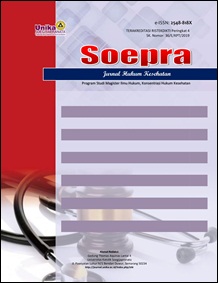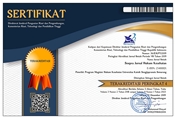Implementation Regulated in the Minister of Health Indonesian Republic Number 856/Menkes/ Sk/Ix /2009 about Hospital Emergency Installation in Bendan Pekalongan City Hospital
Abstract
Hospitals in Indonesia are part of the health care system. The health services are started from Emergency Installation, which provided emergency service. An emergency is a life-threatening and disabling condition requiring fast, precise, effective and quality action. It can be achieved if the hospital has a service standard in the Emergency Installation. Emergency Installation Standards are set out in the Ministry of Health's Decree on Hospital Emergency Installation Standards. The research problems of this study were how the implementation of Emergency Installation standard and what factors affect the implementation. This study aimed to investigate the implementation of Hospital Emergency Installation Standards.
This study is a qualitative study with the juridical sociological approach. The juridical aspect of this study is the regulation of health minister about Hospital Emergency Installation Standards, while the sociological aspect is the implementation of the regulation by the hospital. The legal material sources of the study include primary and secondary law materials. The data were collected through interviews and literature review.
The results show that Emergency Installation Standards are regulated in Law number 44 of 2009 on Hospital. Specifically, Emergency Installation Standards have been regulated in the Minister of Health Indonesian Republic Number 856/Menkes/ SK/IX /2009 about Hospital Emergency Installation. On hospital Emergency Installation Standards. However, the reality in the field, the hospital has not implemented the regulation well, resulted in the poor quality of emergency services. Thus the patient's right to get service quality becomes neglected.
The supporting factors of the implementation of Emergency Installation Standards were the high motivation of human resources, while the obstacles factors were less strategic of the hospital location, the constraints of medical equipment financing, and the lack of attention from hospital owners.
Keywords
Full Text:
PDFReferences
Abdul Wahab Solichin, 2012, Analisis Kebijakan: Model-model Implementasi Kebijakan Publik, Jakarta: Bumi Aksara.
Agus Purwanto Erwan dan Ratih Diah S, 2015, Implementasi Kebijakan Publik: Konsep dan Aplikasinya di Indonesia. Yogyakarta: Gava Media.
Denhardt, Robert B, 1995. Public Administration an Action Orientation, Wadworth Publishing Company: New York
Friedman M. Lawrence, 2009, Sistem Hukum ; Perspektif Ilmu Sosial (The Legal System ; A Social Science Perspective), Bandung: Nusa Media.
Hakim Abdul, 2014, Dinamika Manajemen Sumber Daya Manuasia. Semarang: EF Press.
Hardiati Hermien K, 1998, Hukum Kedokteran; Studi Tentang Hubungan Hukum Dalam Mana Dokter Sebagai Salah Satu Pihak. Bandung: Citra Aditya Bakti.
Herlambang Susatyo, 2016, Manajemen Pelayanan Kesehatan Rumah Sakit, Yogyakarta: Gosyen Publishing.
Kelsen Hans, 2010. Pengantar Teori Hukum. Bandung: Nusa Media.
Wahyati Endang. dkk – Unika, 2015, Petunjuk Penulisan Usulan Penelitian Dan Tesis. Semarang: Program Studi Magister – Unika Soegijapranata.
Rahardjo Satjipto, 2006, Ilmu Hukum, Bandung: Citra Aditya Bakti.
RI, Depkes, 2012, Pedoman Teknis Bangunan Rumah Sakit Ruang Gawat Darurat. Direktorat Bina pelayanan penunjang medik dan sarana kesehatan direktorat bina upaya kesehatan kementerian kesehatan RI.
RI, Kepmenkes, 2009, No. 856/Menkes/SK/IX/2009 tentang standar Instalasi Gawat Darurat (IGD) Rumah Sakit.
RI, Undang - Undang No. 36 tahun 2009 tentang Kesehatan.
RI, Undang -Undang No. 44 tahun 2009 tentang Rumah Sakit.
George III Edward, Implemeting Public Policy, 1980, diakses melalui http://mulyono.staff.uns.ac.id/2009/05/28/model-implementasi kebijakan-george-edward-iii/ diunduh 10 Januari 2018
DOI: https://doi.org/10.24167/shk.v5i1.1572
Refbacks
- There are currently no refbacks.
Copyright (c) 2019 SOEPRA







